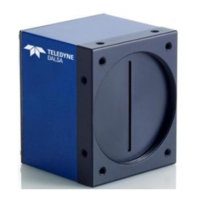Spyder3 S3-14 and S3-24 Monochrome Camera User's Manual 49
Teledyne DALSA 03-032-20117-01
2. The digital offset (sdo com m and) enables the subtraction of the ―artificial‖ A/ D offset (the analog
offset) so that application of the PRNU coefficient doesn’t resu lt in artifacts at low lig ht levels due to
the offset value. You may want to set the sdo value if you are not using FPN correction but want to
perform PRNU correction.
3. Photo-Response Non-Uniformity (PRNU) coefficients (calculated using the ccp or cpa commands)
are used to correct the difference in responsivity of individual pixels (i.e. given the same amount of
light different pixels will charge up at different rates) and the change in light intensity across the
image either because of the light source or due to optical aberrations (e.g. there may be more light in
the center of the image). PRNU coefficients are multipliers and are defined to be of a value greater
than or equal to 1. This ensures that all pixels will saturate together.
4. Background subtract (ssb command) and system (digital) gain (ssg command) are used to increase
image contrast after FPN and PRNU calibration. It is useful for systems that process 8-bit data but
want to take advantage of the cam era’s 12 bit d igital p rocessing chain. For examp le, if you find that
your image is consistently between 128 and 255 DN(8 bit), you can subtract off 128 (ssb 2048) and
then multiply by 2 (ssg 0 8192) to get an output range from 0 to 255.
Analog Signal Processing: Setting Analog Gain and Offset
All analog signal processing chain commands should be performed prior to FPN and PRNU calibration
and prior to digital signal processing commands.
Note: This command will invalidate the LUT calibration for the 4k model of camera. Use the ssg
command instead.
Setting Analog Gain
Sets the cam era’s analog gain value. Analog gain is m u ltiplied by the analog signal to increase the signal
strength before the A/ D conversion. It is used to take advantage of the full dynamic range of the A/ D
converter.
Camera Link Command
t Tap selection. Use 0 for all taps or 1
to 2 for individual tap selection
f Gain value in a range from –10 to
+10dB.
To return the current analog gain setting, use the
command gcp or get sag.
Calibrating Camera Gain
Instead of manually setting the analog gain to a specific value, the camera can determine appropriate gain
values. This command calculates and sets the analog gain according to the algorithm determined by the
first parameter.

